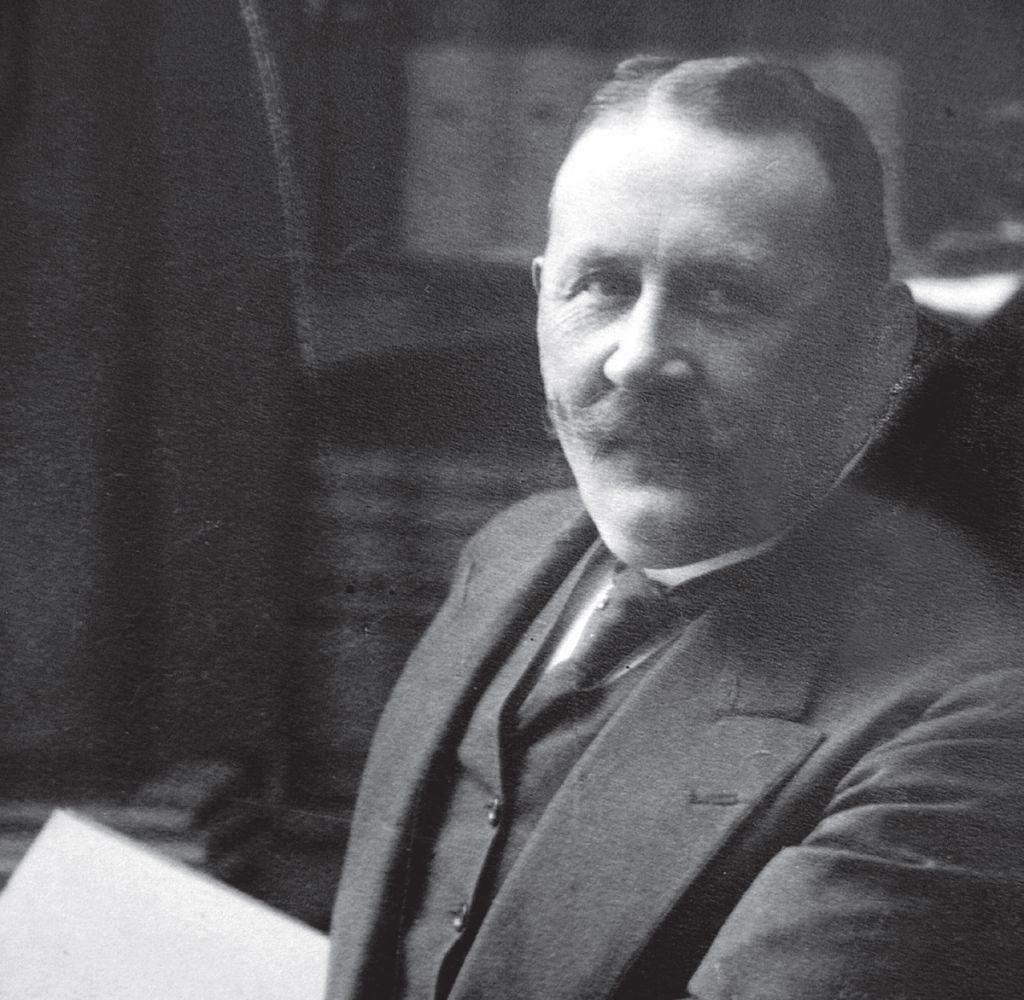Władysław Długosz (1864–1937) – teacher, industrialist, politician

“On the occasion of 50th anniversary of your career in the oil industry, work full of hardships, impetus and inexhaustible energy, the General Assembly of the National Petroleum Company, on behalf of the entire Polish oil industry, sends you, Honourable Mr Chairman, best wishes for further fruitful, effective and successful work for the good of the country and oil industry.” telegram dated May 14th, 1937
First steps in the oil industry
Władysław Długosz was born in 1864 in a Cracovian intelligentsia family. His father Franciszek was a judge, and mother Maria nee Honneich came from Switzerland. In Kraków, he completed the sixth grade of secondary school, then he went to Prague, where he took up technical studies. Perhaps that was where he had his first contact with the oil industry, experiencing a stage of intensive development at that time. At the turn of the nineteenth century, Galicia came third in extracting the black gold in the world and the chance to earn a fortune out of oil mining attracted foreign capital. Around 1874, petroleum was mined not only in Bóbrka but also in Wietrzno, Rivne, Płowce, Sękowa, Siary, Ropica and Harklowa. Young and ambitious Władysław Długosz also dreamt of quick profit. In 1887, he came to a small village of Siary near Gorlice. It was there, in the nearby manor forest (the so-called Pusty Las), that an oil well was established in 1852. It was the beginning of a pioneer oil mine belonging to prince Stanisław Jabłonowski.
A wealth of experience, the bankruptcy of the first company
Initially, Długosz worked as a gymnastics teacher in Gorlice, but petroleum business was his destiny. He started from scratch. He gained oil-drilling experience in the mines in Siary, Sękowa and Ropica Ruska. He quickly ascended the career ladder: from a blacksmith’s assistant, through a shaft mining helper to a shift driller. In 1889, after a one year of practice in baron Brunicki’s mine in Klęczany near Nowy Sącz, he obtained a mine manager diploma. He did not stop there, however. In 1890, he started work in Kryg and Kobylanka, where a Canadian oil entrepreneur William Henry McGarvey conducted drilling with the use of a new system. In the same year, he was ready to become an independent entrepreneur. He invested all his savings in the search for oil in Siary. He lost all his fortune but he found nothing.
Business and love – part one
This failure diminished the chance of winning the hand of Kamila Dembowska – the beautiful daughter of the owner of Siary. The desire to win the approval of Kamila’s hostile father was one of the main reasons why Władysław Długosz had decided to seek his fortune in oil extraction. He wrote about his difficult situation in a letter to his beloved: “I know that the reason for all misunderstandings between me and your father, both domestic ones and those in business matters, is precisely what he called, this superhuman leap that I wanted to make – but why am I guilty of getting attached to you with all my heart and soul?”.
Władysław Dembowski not only threw obstacles at the relationship of Długosz with his daughter but also competed with him in business. And just like him, he also failed in his exploration of petroleum in Siary.
Black gold rush in the “Galician Klondike”
Długosz continued his efforts – he wanted to win money and love. in 1893, having no funds for running his own business, he found employment in a managerial position with Bergheim & McGarvey oil company. He quickly established a friendly relationship with the head of the company William Henry McGarvey, at whose initiative, together with the illiterate but extremely talented Jan Rączkowski of Siary, he went on a special mission to Boryslav in 1896.
In the second half of the nineteenth century, Boryslav attracted people who wanted profit and sensation. They were very often speculators, as well as poor people looking for a job. Wages were very low, so the poorest people called “łebacy” sometimes drew (“łebali”) oil from puddles and roadside ditches using horsehair or grass. Boryslav was called the Galician Klondike at that time – it was a reference to the “gold rush” by the Canadian Klondike river, which attracted crowds of people from all over the world in search of the precious metal in the 1890s.
The breakthrough discovery of “deep Boryslav”
In Boryslav, Władysław Długosz, equipped with a Canadian drilling machine, together with his assistant Jan Rączkowski, began pioneering deep drilling in the area called Na Potoku. Initially, it did not bring the expected results because the drills got stuck in wax deposits at the depth of 500 meters. Nobody believed that these efforts were going to be successful but Długosz was not giving up. He upgraded the construction of the Canadian crane on his own and introduced casing pipes, iron drilling rods and eccentric drill bits. In 1896, at the depth of almost 1000 meters, he found the second layer of oil deposits, the so-called deep Boryslav. The first well had a capacity of 40 tons per day. Długosz’s discovery caused a large part of the oil drilling industry to be moved from West Galicia to eastern areas, creating the so-called eastern oil basin.
Business and love – part two
The discoverer made one more dream come true – he married Kamila Dembowska in 1896 and bought the manor in Siary from his father-in-law. After conversion, it became the Długosz family estate. Petroleum industrialists were best men at his wedding – William Henry McGarvey and Wojciech Biechoński, the mayor of Gorlice. From the marriage with Kamila Dembowska four children were born: Maria, Tadeusz, Jan and Tymoteusz.
In recognition of his activity, Długosz was appointed the manager of several McGarvey’s mines in Boryslav, thus entering the most spectacular period of his petroleum career. He did not stop there, however. In 1908, he became independent and established his own mining companies: Długosz-Łaszcz, Dąbrowa and Galicyjska Spółka Naftowa (Galician Petroleum Company) with baron Popper and with his father-in-law Władysław Dembowski. Soon he became the owner of 30 oil wells with deep boreholes. The monthly production was as high as 1,300 wagons and that made Długosz an oil mogul.
Social and political activity in Galicia
His financial and personal successes encouraged him to become involved in social and political activity. He was elected to the Diet of Galicia and Lodomeria. He got politically connected with the Polish People’s Party, and after its division, he founded the Polish People’s Party “Piast” together with Wincenty Witos. In 1911 he became a member of the Viennese Imperial Council and minister of Galicia.
Bearing in mind the needs of oil mining in Boryslav, he supported initiatives such as energy, telephone and telegraph networks, construction of roads and housing for employees. These activities brought him widespread acknowledgement.
As a political activist and philanthropist he took care of the socio-economic development of Gorlice District. Among other things, he initiated the establishment of the District Agricultural Society, commercial partnership Sierp and associations of dairy producers. He supported education, mainly through the construction of primary schools. In Gorlice itself, he created a dormitory for Polish and Lemko rural youth. He financially supported scout organisations, sports and sightseeing movement. He purchased a plot of land for the construction of the Karpatia sports stadium in Glinik Mariampolski (today a district in Gorlice) and allocated 1000 zlotys for the development of sports activities. He founded the headquarters of the Polish Gymnastic Association “Sokół”, which housed the first cinema in Gorlice, and did not spare any funds for the reconstruction of the historic Józef Oblubieniec Najświętszej Maryi Panny (st. Joseph the Spouse of the Virgin Mary) church, destroyed during the war in 1914-1915.
Crisis time: over-extraction of petroleum and its consequences (1907-1908)
The rapid increase of extraction in the developing oil industry caused a serious crisis in this sector. The excessive supply of raw material caused a drop in the price of oil from 5-7 crowns to 1 crowns per 100 kg. This meant enormous losses for producers, as revenues from sales did not cover the costs of its extraction and processing.
In 1908, in Tustanowice, a record-breaking well was drilled in a shaft called Oil City, from which over 100 rail cars of oil were obtained daily. It was the largest shaft of Galicia, which became a symbol of the oil industry. Its efficiency was so great that oil overflowed the mining tanks and spilled around. Its price dropped almost to zero at that time.
The question then arose: what to do with the excess of raw material and what else could be done with the oil? The National Petroleum Society started to propagate the idea of using oil not only as a source of light, but also as fuel material in factory boilers and transport.
The National Petroleum Association started efforts to convince the Austrian government to introduce oil as fuel in state railways. It was not an easy task, as it required the government to incur capital expenditures for the construction of fuel tanks at stations, rebuilding of furnaces in steam engines, and the construction of a refinery specialising in separating gasoline from crude oil. Długosz’s opinion, as the discoverer of Boryslav Basin, was of considerable importance in this lobbying action.
Oil industry lobbyist
A breakthrough in the lobbying campaign was the visit of the Minister of Railways, dr. Derszatka in Boryslav. Dlugosz (Sejm deputy and member of the National Department of the Petroleum Society) served as a host who, by using his personal charm and factual arguments, tried to visualise the benefits of fuelling the railway with oil-derived fuel to the minister. On the second day of the visit, a preliminary agreement was drawn up with the ministry, which undertook to collect 150,000 wagons of oil for powering locomotives. The agreement was approved by the National Union of Oil Producers, which was established on July 5, 1908 in the town hall of the Lviv city council. Thanks to this agreement, large ground tanks with a capacity of 30,000 wagons were soon built in Boryslav – as it soon turned out, they were too small in relation to the rapidly growing oil production. The government, however, postponed the construction of another series of tanks. At the same time, the foreign company Vacuum Oil Company, which opened a refinery in Galicia, began to express keen interest in purchasing large amounts of crude oil. Lobbyists (Długosz, Wolski, Zamoyski) resorted to a ruse – they began to negotiate with the American company the possibility of selling oil, which was to be contingent upon the investments in the construction of tanks. At the same time, an idea was propagated in Vienna whereby the country gives its valuable natural resources (“black gold”) into American hands. The Austrian government decided, under pressure, to build further tanks, this time with a capacity of 54,000 wagons.
Sejm deputy of the Second Polish Republic – His Excellency Władysław Długosz
After the First World War, Długosz as a deputy worked to rebuild the destroyed country, held various positions, collected medals for his activities and services to the Polish oil industry.
On the contemporary political scene he marked himself as the author of the famous speech from 1917 delivered in the Military Commission of the Austrian Delegation, in which he calculated painful harms that the Polish population had suffered under the Austrian partition. In 1917 he became the president of the National Petroleum Society and held this function until June 24, 1937 – the day of his death. He rested in the family mausoleum in Sękowa.
Inspirations:
- Gucwa Aleksander, Władysław Długosz 1864-1937, pionier rozwoju przemysłu naftowego, (Władysław Długosz 1864-1937, a pioneer of the development of the oil industry) in: sekowa.info [accessed on 3/12/2015]
- Kobylarczyk Katarzyna, Wielki Wybuch (Great Explosion) 1914-1918, Kraków 2014 [accessed on 3/12/2015]
- Mowa Eksc. Władysława Długosza wygłoszona dnia 14 grudnia 1917 roku w Komisyi Wojskowej Delegacyi Austryackiej (Speech by His Excellency Władysław Długosz delivered on December 14, 1917 before the Military Commission of the Austrian Delegation), from the collection of the PTTK Museum in Gorlice
- Pabis Tadeusz, Senator Władysław Długosz, in: Regionalna Fundacja Upowszechniania Historii Przemysłu Naftowego w Regionie Gorlicko-Bieckim
- Pabis Tadeusz, Władysław Długosz, Tuchów 2003
- Pabis Tadeusz, Śladami gorlickich naftowców (Trails of Gorlice Oilmen), Libusza 2006
Source of the photo: Muzeum Przemysłu Naftowego i Etnografii w Libuszy (The Museum of the Oil Industry and Ethnography in Libusza) (archive of Anna and Tadeusz Pabis)

